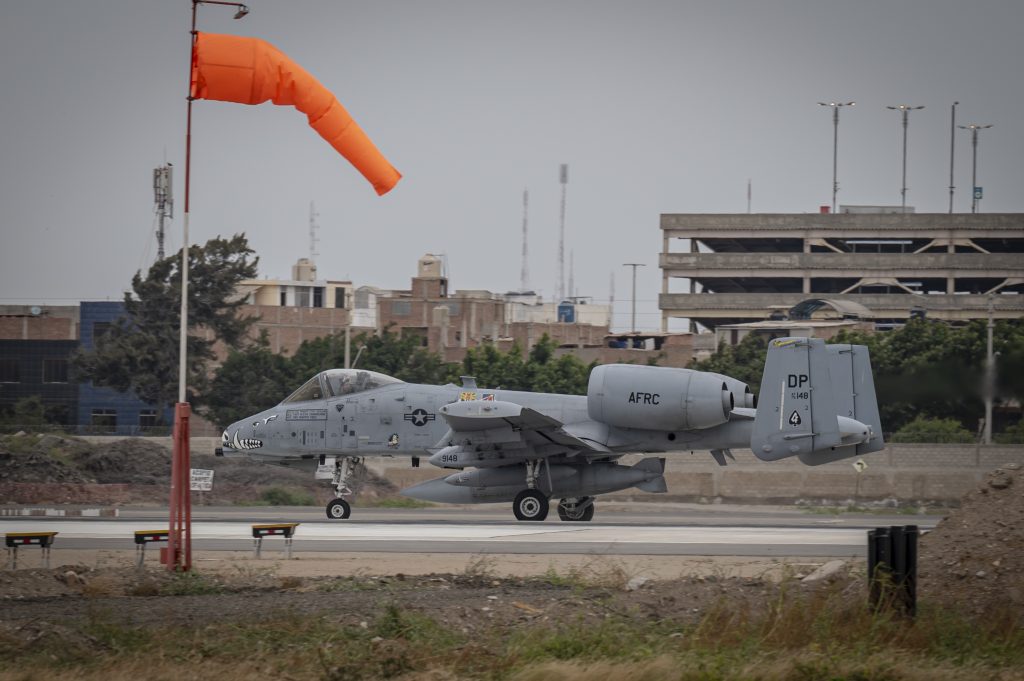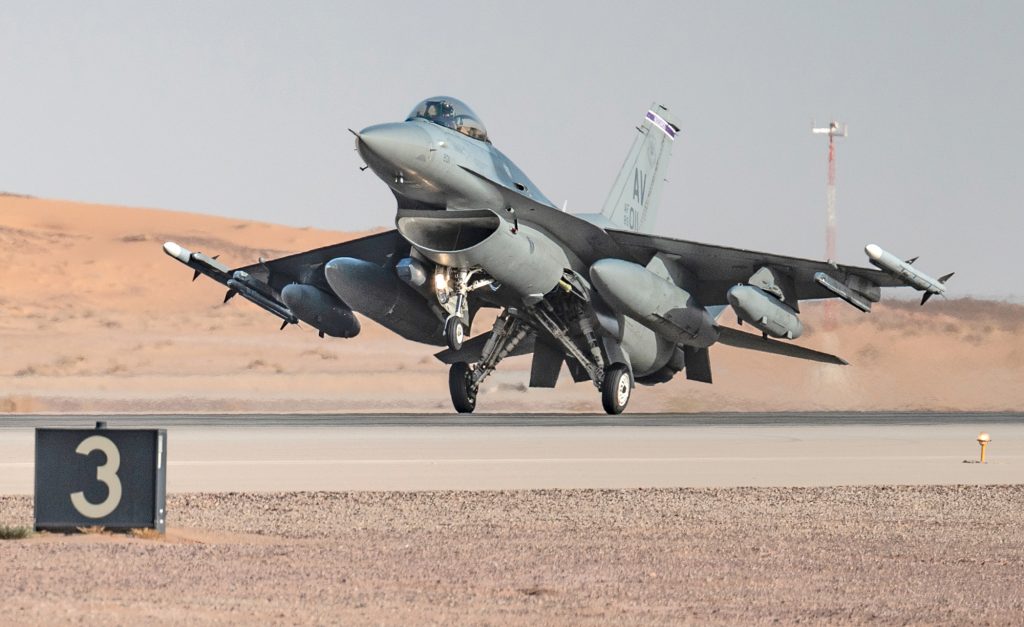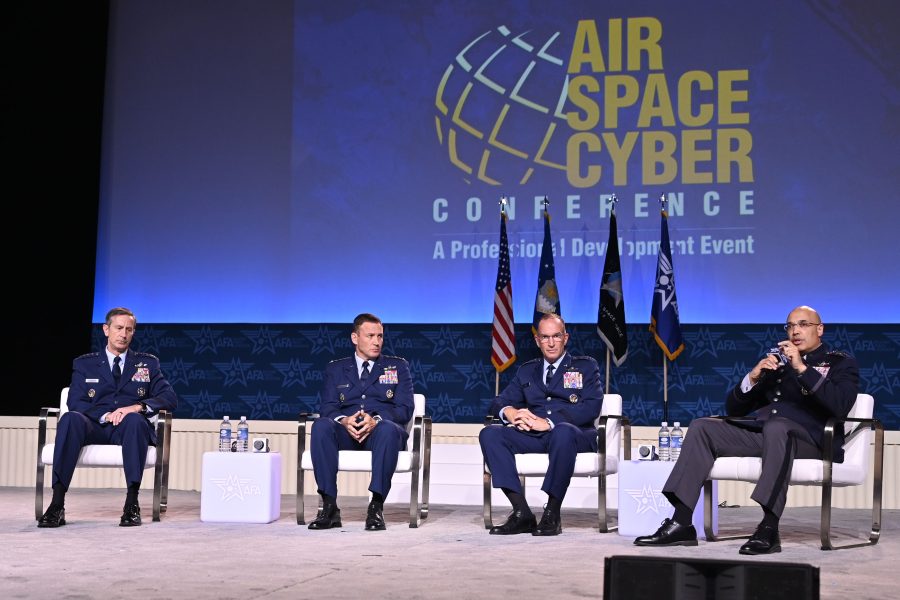NATIONAL HARBOR, Md.—The Air Force and Space Force will have to manage a delicate balance between building readiness and preparing forces as they conduct more realistic, large-scale exercises, senior leaders said Sept. 18 at AFA’s Air, Space & Cyber Conference.
“An exercise is a great way to build skill sets. We build interoperability, and there’s a lot to be gained,” Gen. Kevin B. Schneider, commander of Pacific Air Forces, said during a panel discussion. “There’s also a burn that’s associated with exercises.”
The Air Force wants to move towards more limited-notice, large-scale exercises. That push is headlined by REFORPAC, a roughly two-week exercise set to place across the Pacific next summer, which will integrate the U.S. Air Force with U.S. Indo-Pacific Command’s plans for operationally relevant training for a fight in which forces need to disperse to different bases under simulated attack and communications may not be available. REFORPAC is modeled on the Cold War-era REFORGER exercise aimed to prepare the U.S. to face a threat from the Soviet Union. The Air Force is already moving in that direction with the Air Combat Command-led Bamboo Eagle exercise in 2024 and the Air Mobility Command-led Mobility Guardian last year.
“We’re understanding better how the training events need to be improved,” Air Force Chief of Staff Gen. David W. Allvin told Air & Space Forces Magazine in August. “We’re putting together more regional training sites so they can deploy before they get to a big Bamboo Eagle. Now we look to expand that because we’ve got to scale it to the entire Air Force.”
However, exercises, while not real-world fights, do impact readiness. Aircraft are flown, using up equipment and taxing Airmen.
“For us, as we continue to do more, we have to take a hard look at the prioritization and understand the impacts on readiness because we do not know when the next crisis is going to happen and we’ve got to be on our toes for all that,” Schneider said. “It’s an ongoing focus item … to make sure that at the same time, we don’t consume too much of our force to give us the opportunities to respond.”
The Air Force conducts exercises for several different reasons. In addition to training the force to fight, exercises are often alliance-building events. Some are diplomatically driven to build relationships with countries.
In 2023, the Air Force brought A-10 Warthog close air support aircraft and more to South America, an ofteen-overlooked area in U.S. military circles, for an exercise led by U.S. Southern Command.

“The influence the [People’s Republic of China] has there is immense,” the head of Air Force Reserve Command Lt. Gen. John P. Healy said. “So it was an absolute show of force. And what we tried to do is we tried to put a mini Air Force there, everything from C-17, A-10, C-130s, tankers to show that we have the capability, with many eyes watching, of doing things like this.”
But top commanders said they do not want to tax the force too much.
“We come up with events, and we’ve got a few where a Delta commander feels like this is not a readiness-generating event, there are no learning objectives that satisfy any of my requirements to meet a EUCOM or PACOM requirement, we don’t send the force element to go,” said Lt. Gen. David N. Miller, the head of Space Operations Command. “That has generated some hard feelings reports, which are my job to receive. But I think that has also disciplined our structure.”
At the tactical level, wing commanders say they also carefully judge tradeoffs to ensure they don’t overextend their troops. The 31st Fighter Wing based at Aviano Air Base, Italy, has deployed its F-16s to the Middle East twice in the last year to fend off Iranian aggression while still fulfilling multiple exercises focused on integrating with European allies and preparing to defend NATO, conducting a myriad of exercises in the past few months.
Wing commander Brig. Gen. Tad D. Clark echoed senior leaders, noting his Airmen and aircraft cannot be overused and that careful consideration must be made not to conduct too many exercises that would harm his ability to be ready to fight or scale down how many forces the wing commits to an exercise.
“We have a strategic calendar, we think it through, we see what the taskings are, and we try to plot it out, so that we give it deliberate thought of what we’re committing ourselves to, what we’re committing ourselves to, and what we’re not able to fully support,” he told Air & Space Forces Magazine.
“That’s why we try to be as deliberate as possible and have good communication with the headquarters, expressing what we’re able to do, and then lay out the [tradeoffs],” Clark added. “There are some exercise opportunities that have not been tasked but have been made available, and we’ve respectfully communicated that we’re just going to have to … not participate based on our operational cycle, how busy we are, how many aircraft we have, and some limitations—because we could do it all, but to what cost is the question.”

Senior leaders say they are cognizant of those concerns.
“Exercises help build readiness, but exercises also come with a cost,” Schneider told Air & Space Forces Magazine in an interview. “You can exercise so much that it actually starts to decrement your readiness, because you can’t reconstitute.”
“It’s a fine balance, and I work with the wing commanders to understand how much is too much,” Schneider continued. “When it comes to exercising, there’s tremendous benefit that comes from it. There’s also tremendous benefit from being able to just focus on the things you weren’t able to do during an exercise: take care of maintenance, take care of some of the other things, and make sure that your people and your equipment are healthy to be able to respond across the spectrum.”


